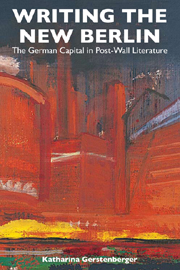Book contents
- Frontmatter
- Contents
- Acknowledgments
- Introduction: Newness and Its Discontents: Berlin Literature in the 1990s and Beyond
- 1 Erotic Sites: Sexual Topographies after the Wall
- 2 Bodies and Borders: The Monsters of Berlin
- 3 Multicultural Germans and Jews of Many Cultures: Imagining “Jewish Berlin”
- 4 Goodbye to East Berlin
- 5 Looking for Perspectives: The Construction at Potsdamer Platz
- Conclusion
- Bibliography
- Index
2 - Bodies and Borders: The Monsters of Berlin
Published online by Cambridge University Press: 05 February 2013
- Frontmatter
- Contents
- Acknowledgments
- Introduction: Newness and Its Discontents: Berlin Literature in the 1990s and Beyond
- 1 Erotic Sites: Sexual Topographies after the Wall
- 2 Bodies and Borders: The Monsters of Berlin
- 3 Multicultural Germans and Jews of Many Cultures: Imagining “Jewish Berlin”
- 4 Goodbye to East Berlin
- 5 Looking for Perspectives: The Construction at Potsdamer Platz
- Conclusion
- Bibliography
- Index
Summary
Ich lebe seit zwanzig Jahren in der siamesischen Stadt.
[I have lived in this Siamese city for twenty years.]
— Peter Schneider, Der MauerspringerThis chapter explores the significance of the numerous references in literature, the visual arts, and scholarly essays to the pathological specimens on public display in one of Berlin's oldest hospitals, the Charité. Founded in 1898 by the pathologist and politician Rudolf Virchow, the Berliner Medizinhistorisches Museum der Charité was closed for decades after it sustained severe damage in the Second World War. It reopened its doors to the public in 1998 in a flurry of publicity. Recognizably human, the deformed fetuses on display inspire reflections on borders — geographical, physical, moral, symbolic, historical, and conceptual — and their meanings for Berlin after its defining border disappeared in its physical manifestation but not as a mental construct. Images of pathology such as the ones in the Charité question not only the possibility of the city's often-invoked return to “normalcy” but the desirability of such a move.
Pushing against the boundaries of human existence, the pathological body serves as a point of departure for political reflections as well as a repertoire of images for the aesthetic representation of Berlin and its shifting borders. The incorporation of extraordinary bodies and their century-long presence in Berlin into works of art illustrates the changing approaches to borders and borderline phenomena with a focus on the future as European unification and globalization rapidly redraw real and imagined lines of exclusion and inclusion.
- Type
- Chapter
- Information
- Writing the New BerlinThe German Capital in Post-Wall Literature, pp. 52 - 76Publisher: Boydell & BrewerPrint publication year: 2008



